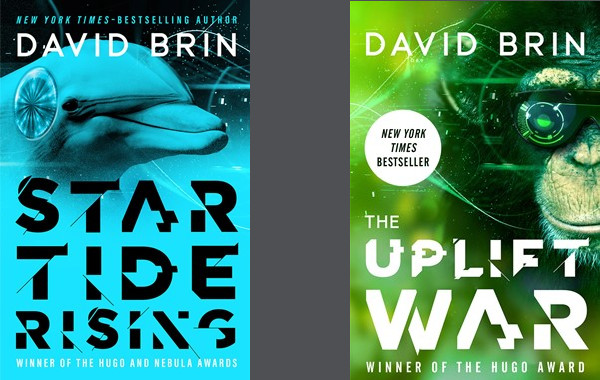December 27, 2007 (copy-edited January 5, 2023) — There are times when dreams really do explain themselves, at least in part.
This night was one of those when, through at least two re-awakenings, the primary providence of my dreams was as clear as the narrative structure of them was solid and the imagery consistent.
I dreamed of unusual family dynamics - unusual in (my) dreams at least - for there was no conflict there, in particular, no conflict between my brother and myself. No, we were almost as one. I dreamed also of animals and aliens and a nefarious plot by certain aliens to harm not just one cetacean but all of them, and perhaps all human beings as well.
Yes, I've been reading science fiction again. In particular, prior to going to sleep, I had been reading David Brin.

Published in 1983 and 1987, respectively, I stumbled across these novels in an omnibus edition entitled Earthclan, while seeking a mouse for my computer at a local Sally Ann. I have read some of Brin's short fiction over the years and was aware that he has been a very big name in "the New Space Opera" for a long time, but had somehow missed reading any of his novels. Judging by these two, Brin's Uplift are excellent examples of many of the strengths, along with a few of the weaknesses, of the galaxy-spanning, big-picture SF that arguably began with Olaf Stapleton's Last and First Men.
These books, which are in fact the second and third of (so far) six novels set in the same universe, are set several hundred years in the future. Humanity (or "mankind", the term Brin mostly uses, along with a self-conscious explanation for the sexist term; I wonder whether, after a further 20 years of feminism, he still does) has reached the stars in "slowships" (sub-light speed starships), only to discover that there is not only life beyond our solar system, but that our galaxy, along with four of our galactic neighbours, is positively teeming with life. Humanity has, in fact, encountered a three billion year-old civilization encompassing almost uncounted species, all of which - with the exception of "Man" "himself" - were "uplifted" by an earlier civilization. In galactic legend, only one civilization, the Progenitors, had reached the stars without the aid of another.
Humanity is regarded as an upstart race, orphans or "wolflings", because they alone have reached the stars without "Patrons", another race who would have Uplifted us - found us in a pre-sentient state and genetically manipulated us toward full consciousness. And, not so incidentally, who would have had controlled us as a "client species" for a full one hundred thousand years before we too would have been allowed to join Galactic civilization as a sentient species in our own right.
Fortunately (or not) for humanity, as well as for the novels, humanity not only reached the stars without help, it is a Patron, having used genetic manipulation to create fully-sentient races of dolphins and chimpanzees. Unlike other Patrons, however, humans treat their clients as partners (albeit junior partners), including them on their political councils and in their own continued development as new species.
Startide Rising is set on Sreaker, the first starship launched under dolphin command. On what is intended to be a test-voyage, Streaker stumbles upon a derelict fleet of two-billion year-old, moon-sized starships. Before it can return home, with samples that include a mummified alien, the vessel is attacked by not one, but many, armadas of other aliens. They escape - barely - and crash upon the "waterworld" of Kithrup, where they desperately endeavour to make repairs while the aliens battle amongst themselves over-head for the right to the Terrans' prize. It seems these aliens are fanatics, with a religious belief that the Progenitors, the mythical first Patrons, will someday return and that the ancient derelicts may be important clues to their whereabouts.
In some ways, this is fairly standard if well-written space-opera. A new planet to explore, its ecology to understand; chapters written from alien points-of-view; and especially, chapters written from the viewpoint of several of the dolphin characters.
Brin writes excellent battle-sequences and his characters - human and dolphin (there are a half-dozen or so humans involved in Streaker's voyage, along with an obsessive "neo-chimp" geologist) in particular. The aliens are much more thinly-sketched.
The world of Kithrup itself is in many ways the star of the show, in the best tradition of "Hard SF". Not only is there a primitive, pre-sentient species to be discovered, an ecology to be explored and understood, the planet also harbors a secret that will have a significant impact on the novel's outcome, both in terms of the greater plot and on the neo-dolphin Captain Creideiki's own development.
Startide Rising is one of Brin's first novels and in some ways it shows. He juggles too many viewpoint characters and too many subplots for most of them to be fully-satisfying, but the book is more than readable and, compared to most "big-picture" SF novels it is fast-paced and exciting. As well, Brin's interests range beyond SF's traditional love of interstellar warfare and weird planets. Brin has a strong interest in ecology and environmentalism as well as politics and both go well towards balancing the big bangs and bigger space-ships.
The Uplift War is set not long after Streaker's near-miraculous escape from Kithrup, but though its adventure is referred to, it does not make a re-appearance, nor do any of its characters. There is no need for the reader to be familiar with the "first" book in this series to read the "second" (just as I have yet to read Sundiver).
Published four years after Startide Rising, The Uplift War is clearly the work of a more practiced craftsman. At around 500 pages, it is a slightly longer novel, it focusses on fewer characters and is the better book for it.
Set on the planet Garth, one of Earth's few colonies, it is in one sense a coming-of-age novel for Robert Oneagle, a young human man, Athaclena, a young female Tymbrimi, and Fiben Bolger, a neo-chimpanzee ecologist and lieutenant in the colonial militia.
As the novel opens, the planet is being abandoned by its "Galactic" ambassadors in the imminent face of invasion by the pseudo-avian race called the Gobru, a race hostile to the Terrans.
The Terrans, empoverished newcomers to galactic civilization and considered by many to be unworthy of their legal status as full members of it, have few ships in the area and no allies able to come to their direct aid. Within the books first few chapters, the Gobru have destroyed the Terran fleet, occupied the planet and rounded up almost all its human inhabitants. Any rebellion will be left up to Robert Oneagle, Athaclena and the neo-chimpanzees.
On the surface, this is a novel of guerilla warfare, young inter-species love and excellent gosh-wow! SF speculation. The reader has little doubt the Terrans will succeed in their apparently impossible quest to throw the conquerors off their colony; the fun is in finding out just how they manage it. And Brin does not disappoint, as the finale offers quite a few surprises, none of which are a deus ex machina.
If I have a complaint about Brin's vision, it is that he did not completely convince me of the plausibility that his Galactic civilization - so powerful and often so very warlike - could survive for three billion years without destroying itself, despite the vastness of the galaxy and the depths of time.
Despite that caveat, I had a wonderful time diving into his universe and look forward to returning to it (he has written at least six novels against this backdrop). Recommended.

Add new comment